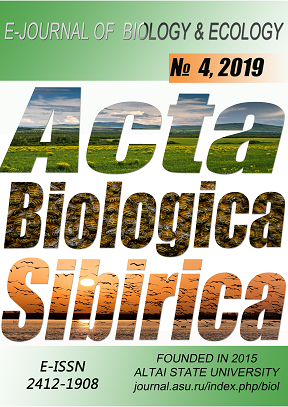Аннотация
В течение 2012-2016 годов нами были проведены исследования структуры популяции безоарового козла в пределах Нахчыванской Автономной Республики. На территории региона среднегодовая численность безоарового козла составила 1174 особи. Возрастной состав популяции представлен 533 (37%) молодыми и взрослыми особями, 283 (19,6%) фертильными самками, 229 (15,8%) детёнышами и 129 особями молодняка (8,9%). Самки составили 45%, самцы – 24%, у остальных возрастных групп пол не был определен. Отношение числа детёнышей (195 особей) к числу самок (283 особи) или индекс рождаемости составил 0,81. Средняя плотность популяции безоарового козла составила 14 особей на 1000 га.
Литература
Çanakçıoğlu H, Mol, T. 1996. Wild Animals Information. Istanbul University Faculty of Forestry Publication. Istanbul 440: 550
Demirsoy A. 1996. Turkey vertebrates: Mammals: Determination of Turkey to investigate the systematic and biological properties of vertebrate fauna and conservation measures. Ankara.
Faculty, Hunting and Wildlife Management Certificate Program, Training Notes, Istanbul (in Turkish).
Huş S. 1974. Hunting animals and hunting. Istanbul University Faculty of Forestry Publication. Istanbul, No. 202, 406
Korshunov VM. 1994. Ecology of the Bearded Goat Capra aegagrus Erxleben 1777 in Turkmenistan. Biogeography and Ecology of Turkmenistan, Monographiae Biologicae. Dordrecht: Springer. Netherlands.
Kuzyakin VA, Chelintsev NG, Lomanov IK. 1990. Metodicheskiye ukazaniya po organizatsii, provedeniyu i obrabotke dannykh zimnego marshrutnogo ucheta okhotnich'ikh zhivotnykh v RSFSR (s algoritmami rascheta chislennosti). Moscow (in Russian).
Luikart G, Pidancier N, Martin J-F, Taberlet P. 2000. Molecular genetics, Systematics and Conservation of Capra Taxa. Workshop on Caprinae Taxonomy. METU, Turkey. p. 45-56.
Mammadov AF. 2016a. Fauna of Nakhchivan Autonomous Republic. News of the Nakhchivan Branch of the National Academy of Sciences of Azerbaijan. A series of natural and technical sciences 12(13): 205–218 (in Azerbaijan).
Mammadov AF. 2016b. Fauna of small in number terrestrial vertebrates of the Nakhchivan Autonomous Republic. News of the Nakhchivan Branch of the National Academy of Sciences of Azerbaijan. A series of natural and technical sciences 13(4): 225-234 (in Azerbaijan).
Mammadov AF. 2017. The origin and phylogenetic branching of mammalian fauna (Mammalia), distributed in the Nakhchivan Autonomous Republic. News of the Nakhchivan Branch of the National Academy of Sciences of Azerbaijan. A series of natural and technical sciences 13(4): 190-198 (in Azerbaijan).
McDonald LL. 2000. Quantitative Methods in Wildlife Monitoring. Workshop Wildlife Monitoring-Recent Developments in Techniques and Applications. Swiss Federal Institute, Switzerland.
Oğurlu I, Başkaya Ş. 2001. Studies in wildlife-inventory and inventory determination. Anlara: Istanbul University (in Turkish).
Oğurlu İ. 2001. Wildlife Ecology. Solomon Demirel University Publications 19: 296 (in Turkish).
Oğurlu İ. 2003. Inventor at Wildlife. Ankara: Republic of Turkey Ministry of Environment and Forestry Nature Conservation and National Parks. Directorate of Hunting and Wildlife (in Turkish).
Red Data Book of the Republic of Azerbaijan. 2013. Fauna. Second Edition. Baku (in Azerbaijan).
Rusanov YaS. 1973. Uchet chislennosti zhivotnykh metodom povtornogo oklada. Metody ucheta okhotnich'ikh zhivotnykh v lesnoy zone. Trudy Okskogo Gosudarstvennogo Zapovednika 9: 62-68 (in Russian).
Sfougaris AI. 1994. Wild Goat Capra aegagrus in Greece: distribution and Status. Biologia Gallo-hellenica 22: 233–240.
Shackleton DM. 1968. Wild Sheep and Goats and their relatives: Status Survey and Conservation Action Plan. IUCN/SSC Caprinae Specialist Group. IUCN, Grand, Switzerland and Cambridge, UK. 1997.
Spitzenberger F. 1968. Zur Verbreitung und Systematik Türkischer Soricinae (Insectivora, Mamm.). Ann. Naturhistor. Mus. Wien 72: 273-289.
Talibov TH, Weinberg PI, Mammadov IB. 2009. Conservation Strategy of the Asiatic Mouflon (Ovis [orientalis] gmelini Blyth) and the Bezoar Goat (Capra aegagrus Erxleben) in Azerbaijan. In: Zazanashvili N, Mallon D. editors. Status and Protection of Globally Threatened Species in the Caucasus. CEPF Biodiversity İnvestments in the Caucasus Hotspot 2004-2009. Tbilisi: CEPF, WWF. Contour Ltd. p. 46–52.
Talybov TG, Weinberg RI, Mamedov IB. 2007. The conservation strategy of the Asian mouflon and bezoar goat in Azerbaijan). Nakhchivan (in Azerbaijan).
Turan N. 1987. Antalya-Termesos wild goat (Capra aegagrus aeggarus L.) development of populations, and problems of today burumi. Wildlife international symposium in Turkey and the Balkan countries, Istanbul. p. 83-105.
Weinberg PL. 2002. Capra cylindricornis. Mammalian Species 695: 1-9.
Авторы, публикующиеся в данном журнале, соглашаются со следующими условиями:
a. Авторы сохраняют за собой права на авторство своей работы и предоставляют журналу право первой публикации этой работы с правом после публикации распространять работу на условиях лицензии Creative Commons Attribution License, которая позволяет другим лицам свободно распространять опубликованную работу с обязательной ссылокой на авторов оригинальной работы и оригинальную публикацию в этом журнале.
b. Авторы сохраняют право заключать отдельные договора на неэксклюзивное распространение работы в том виде, в котором она была опубликована этим журналом (например, размещать работу в электронном архиве учреждения или публиковать в составе монографии), с условием сохраниения ссылки на оригинальную публикацию в этом журнале. с. Политика журнала разрешает и поощряет размещение авторами в сети Интернет (например в институтском хранилище или на персональном сайте) рукописи работы как до ее подачи в редакцию, так и во время ее редакционной обработки, так как это способствует продуктивной научной дискуссии и положительно сказывается на оперативности и динамике цитирования статьи





